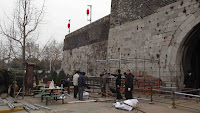Getting a train at 7:00am is never fun (and neither is realising that, on arriving at the station, you've left your passport at home . . . poor Fiona), but doing so meant that we had a good day and a half to explore Nanjing (Nánjīng 南京), the next leg on our tour of China.
After dumping our stuff at the cosy Jasmine Hostel, we headed into town to see the old city wall. Unfortunately the wall at Zhonghuamen had been closed so that preparations could be made for the upcoming Spring Festival celebrations. So we basically ended up spending the afternoon looking at, and walking next to, a big wall.
After the excitement of the wall, we made our way into town and found a bustling central touristy area by the Qin Huai River. There there hundreds of stores and stalls selling the usual tat and questionable snacks. There was one diamond in the rough though, Sarah's new favourite treat; glazed strawberries on a stick.
Back at the hostel we decided that there were not enough "what do you call a man who . . . " jokes in the world. Here are some of our attempts:
What do you call a man who tells it like it is? Frank
What do you call a man with bailiffs at his door? Owen
What do you call a girl on the toilet? Dianarrhea
We're genuinely quite proud of the first two. I think we called it a night after the third.
We had big plans for day two. Plans that did not allow for time wasting or spontaneous adventuring. Slightly unfortunate then that the first thing we did was walk into a random museum that was not in fact the Nanjing Massacre Memorial Hall. If you're a fan of silk, then the Yunjin Museum is for you.
I don't really know how to talk about the Nanjing Massacre, a period that is also known as the Rape of Nanjing. Before coming to China I hardly knew anything about the massacre and I'm not sure that there are many Westerners who do (although Zhang Yimou's recent film Flowers of War might help to change that).
What happened following the Japanese capture of the city in 1937 is nothing short of horrifying. The photos, diary entries, stories and eye witness accounts that are on display at the museum are incredibly moving and frequently impossible to comprehend. For those who want to learn more, there are thousands of sites dedicated to remembering the atrocity. As always, a decent place to start is wikipedia.
The museum itself is very well organised and all displays have English translations. If you ever visit Nanjing then the museum will probably be top of your list of things to see and rightly so. Despite the horrendous subject matter and sombre atmosphere, I would say it was one of the most interesting museums that I have ever visited. It is certainly an unforgettable experience.
In the afternoon we opted for a bit of fresh air and greenery and so made our way to Zijin Shan Park (lit. Purple-Gold Mountain). There was greenery, but I'm not too sure about fresh air. Throughout the park there are many historical sites to visit. We decided that we wanted to see Dr Sun Yat-Sen's Mausoleum (mainly because it was free). Dr Sun is often referred to as "the father of modern China" and as such, his mausoleum attracts millions of Chinese tourists every year. The buildings were beautiful and the view from the top would have been spectacular had it not been for the smog filled sky.
On the way back to the hotel we popped into a Western bar for some cocktails and nachos. Very classy. Despite having been in the city for only a day and a half, we all agreed that Nanjing had made a great first impression. Not only does it have historical significance and legitimate tourist attractions but also trees, parks, rivers, lakes and even hills (it's amazing how much I miss hills). Poor old Tianjin just can't compete.










No comments:
Post a Comment